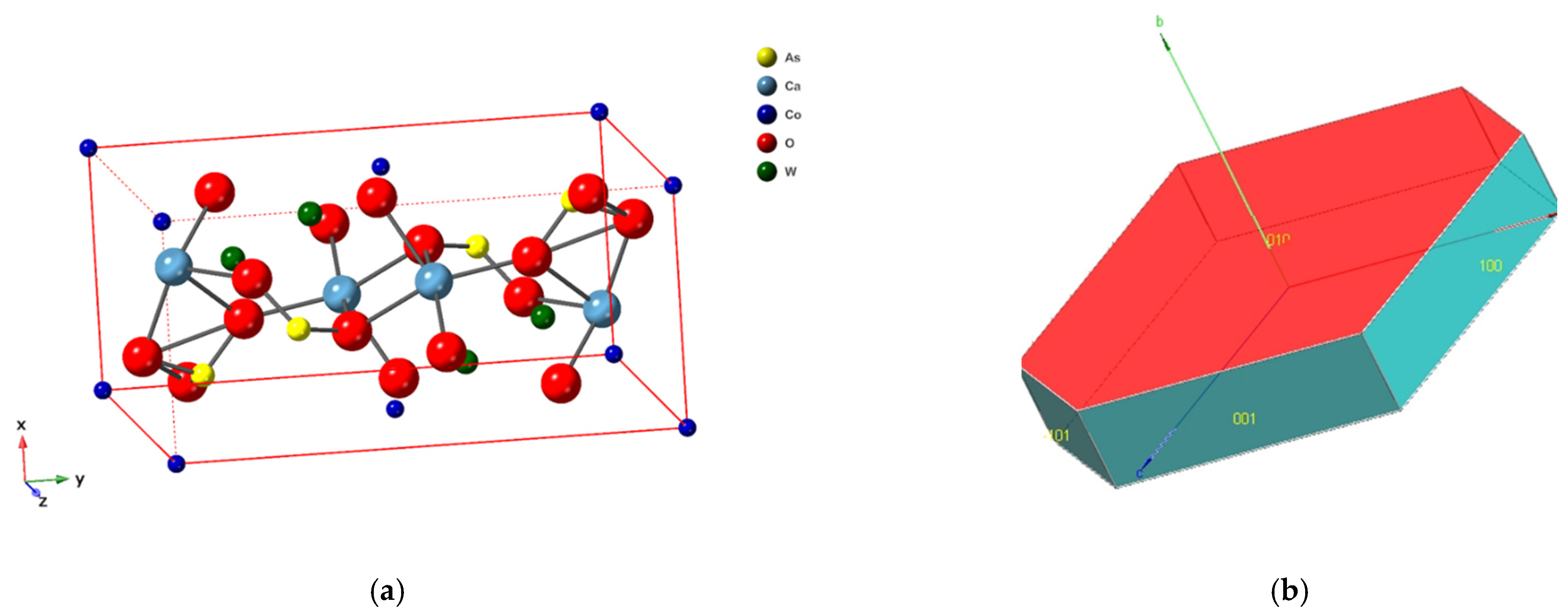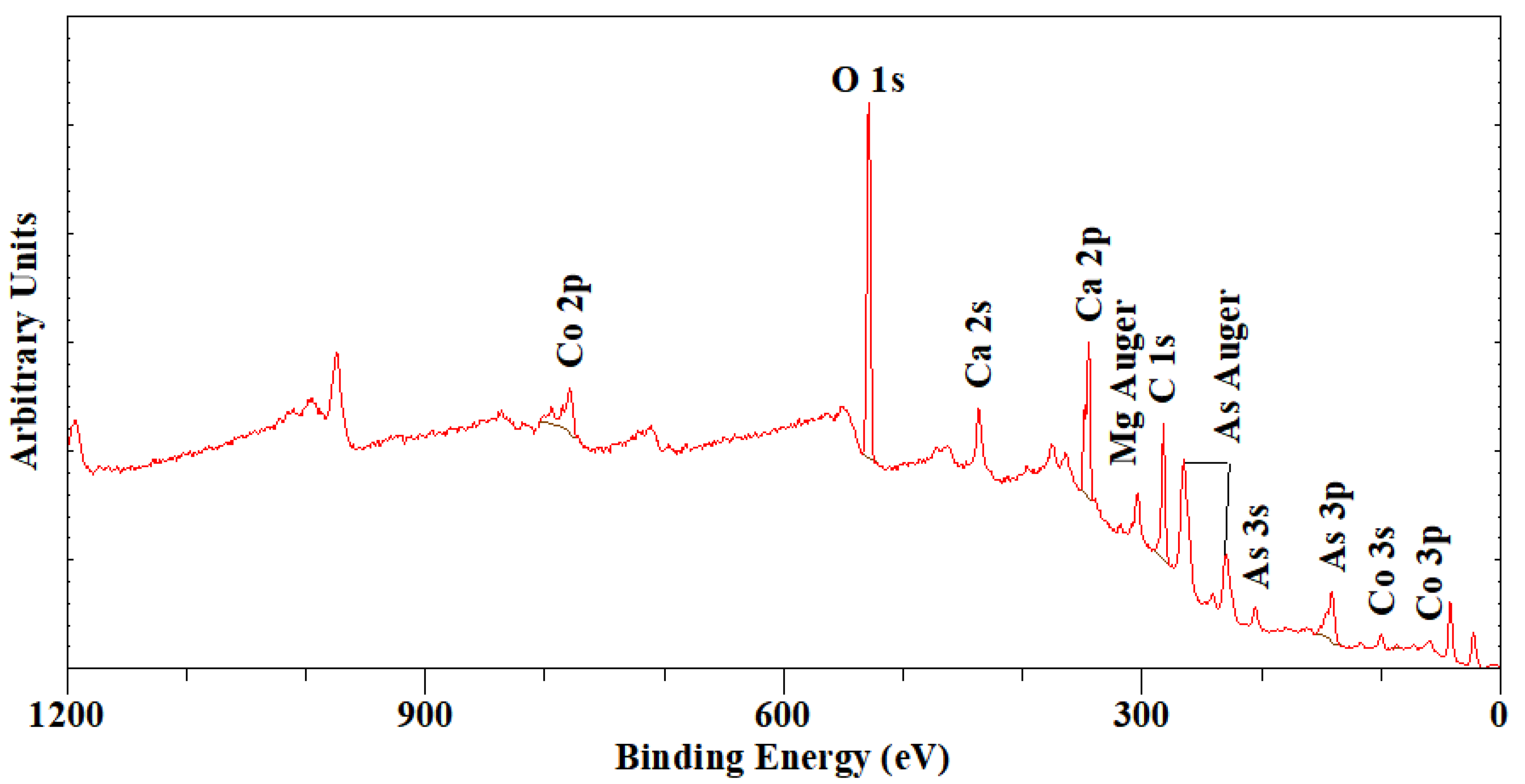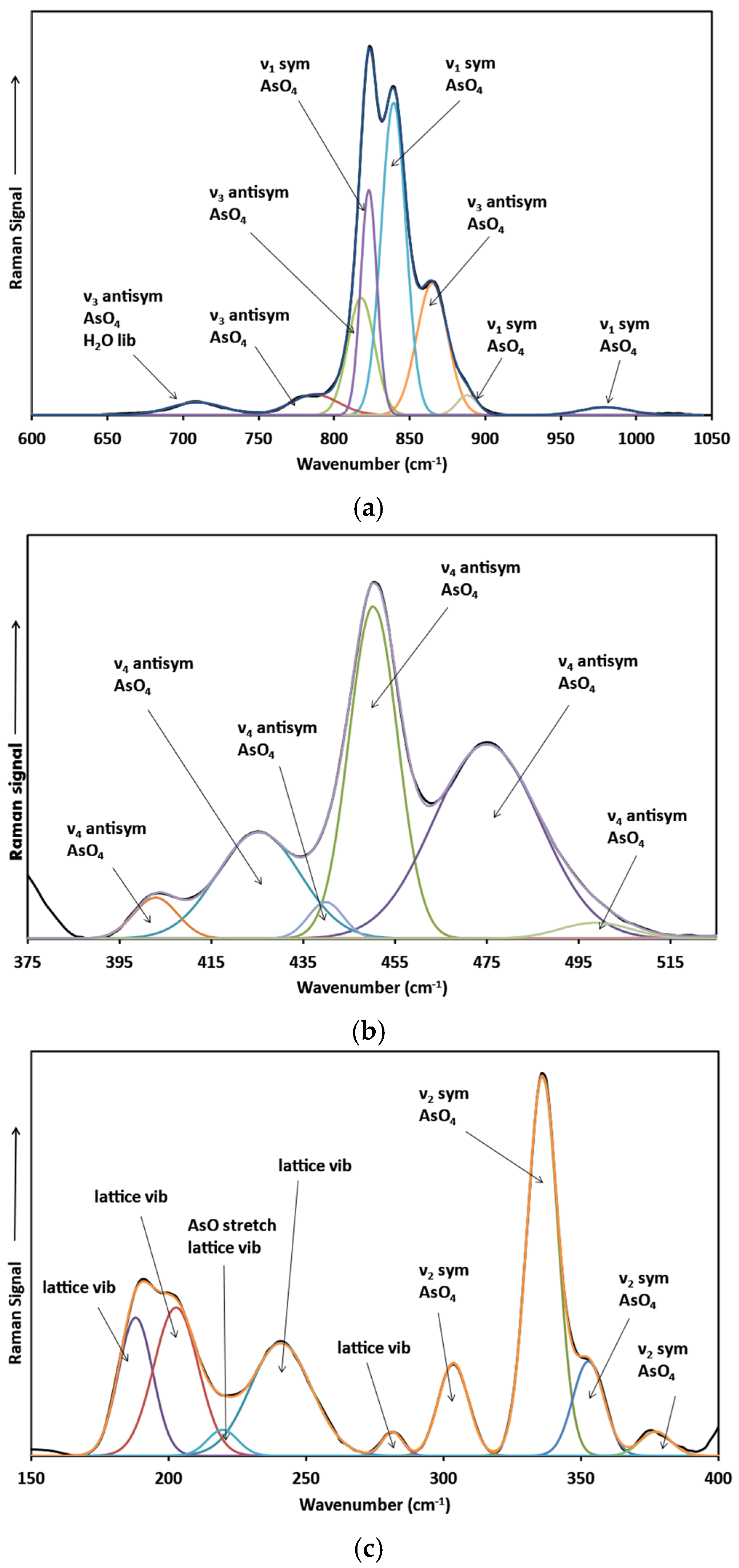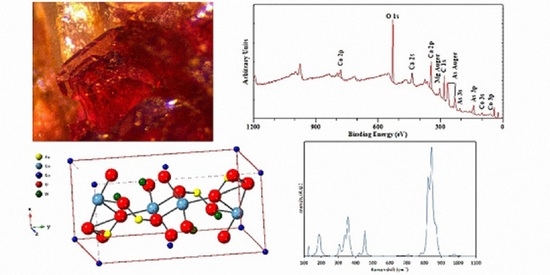In-Situ X-ray Photoelectron Spectroscopy and Raman Microscopy of Roselite Crystals, Ca2(Co2+,Mg)(AsO4)2 2H2O, from the Aghbar Mine, Morocco
Abstract
1. Introduction
2. Materials and Methods
3. Results and Discussion
3.1. Chemical Characterization
3.2. Raman Microscopy
4. Conclusions
Author Contributions
Funding
Institutional Review Board Statement
Informed Consent Statement
Acknowledgments
Conflicts of Interest
References
- Gaines, R.V.; Skinner, H.C.W.; Foord, E.E.; Mason, B.; Rosenzweig, A. Dana’s New Mineralogy—The System of Mineralogy of James Dwight Dana and Edward Salisbury Dana, 8th ed.; John Wiley & Sons, Inc.: New York, NY, USA, 1997; p. 1819. [Google Scholar]
- Anthony, J.W.; Bideaux, R.A.; Bladh, K.W.; Nichols, M.C. Handbook of Mineralogy Volume IV—Arsenates, Phosphates and Vanadates; Mineral Data Publishing: Tuscon, AZ, USA, 2000; p. 680. [Google Scholar]
- Favreau, G.; Dietrich, J.E.; Meisser, N.; Brugger, J.; Ait Haddouch, L.; Maacha, L. Famous mineral localities: Bou Azzer, Morocco. Mineral. Rec. 2007, 38, 345–407. [Google Scholar]
- Favreau, G.; Dietrich, J.E. Die Mineralien von Bou Azzer. Lapis 2006, 31, 27–68. [Google Scholar]
- Weiß, S.; Lengauer, C.L.; Parodi, G. Roselith, Wendwilsonit und kobalt-haltiger Talmessit: Neufunde aus Agh-bar bei Bou Azzer, Marokko. Lapis 2002, 27, 37–41. [Google Scholar]
- Yang, H.; Jenkins, R.A.; Downs, R.T.; Evans, S.H.; Tait, K.T. Rruffite, Ca2Cu(AsO4)2·2H2O, a new member of the roselite group, from Tierra Amarilla, Chile. Can. Miner. 2011, 49, 877–884. [Google Scholar] [CrossRef]
- Lévy, M.; Children, J.G. Account of a new mineral substance. Ann. Philos. 1824, 8, 439–442. [Google Scholar]
- Schrauf, A. Roselite. Jahrb. Mineral. 1874, 868. [Google Scholar]
- Schrauf, A. Zur Charakteristik der Mineralspecies Roselit. Tschermak’s Mineral. Mitt. 1873, 291–293. [Google Scholar]
- Schrauf, A. Monographie des Roselith. Tschermak’s Mineral. Mitt. 1874, 137–160. [Google Scholar]
- Peacock, M.A. Roselite and the rule of highest pseudosymmetry. Am. Mineral. 1936, 21, 589–603. [Google Scholar]
- Kolitsch, U.; Fleck, M. Third update on compounds with krohnkite-type chains: The crystal structure of wend-wilsonite [Ca2Mg(AsO4)2·2H2O] and the new triclinic structure types of synthetic AgSc(CrO4)2·2H2O and M2Cu(Cr2O7)2·2H2O (M = Rb, Cs). Eur. J. Mineral. 2006, 18, 471–482. [Google Scholar] [CrossRef]
- Hawthorne, F.C.; Ferguson, R.B. The crystal structure of roselite. Can. Mineral. 1977, 15 Pt 1, 36–42. [Google Scholar]
- Frost, R.L. Raman and infrared spectroscopy of arsenates of the roselite and fairfieldite mineral subgroups. Spectrochim. Acta Part A Mol. Biomol. Spectrosc. 2009, 71, 1788–1794. [Google Scholar] [CrossRef][Green Version]
- Ross, S.D. Phosphates and other oxy-anions of Group V. In The Infrared Spectra of Minerals; Farmer, V.C., Ed.; Mineralogical Society: London, UK, 1974; Volume 4, pp. 383–422. [Google Scholar]
- Frost, R.L.; Kloprogge, J.T.; Martens, W.N. Raman spectroscopy of the arsenates and sulphates of the tsumcorite mineral group. J. Raman Spectrosc. 2004, 35, 28–35. [Google Scholar] [CrossRef]
- Frost, R.L.; Martens, W.; Williams, P.A.; Kloprogge, J.T. Raman spectroscopic study of the vivianite arsenate minerals. J. Raman Spectrosc. 2003, 34, 751–759. [Google Scholar] [CrossRef]
- Kloprogge, J.T.; Frost, R.L. Raman Microscopy Study of Cafarsite. Appl. Spectrosc. 1999, 53, 874–880. [Google Scholar] [CrossRef]
- Martens, W.; Frost, R.L.; Kloprogge, J.T. Raman spectroscopy of synthetic erythrite, partially dehydrated erythrite and hydrothermally synthesized dehydrated erythrite. J. Raman Spectrosc. 2002, 34, 90–95. [Google Scholar] [CrossRef]
- Martens, W.N.; Frost, R.L.; Kloprogge, J.T.; Williams, P.A. The basic copper arsenate minerals olivenite, cornubite, cornwallite, and clinoclase: An infrared emission and Raman spectroscopic study. Am. Miner. 2003, 88, 501–508. [Google Scholar] [CrossRef]
- Martens, W.N.; Kloprogge, J.T.; Frost, R.L.; Rintoul, L. Site occupancy of Co and Ni in erythrite-annabergite solid solutions deduced by vibrational spectroscopy. Can. Mineral. 2005, 43, 1065–1075. [Google Scholar] [CrossRef]
- Martens, W.N.; Kloprogge, J.T.; Frost, R.L.; Rintoul, L. Single-crystal Raman study of erythrite, Co3(AsO4)2·8H2O. J. Raman Spectrosc. 2004, 35, 208–216. [Google Scholar] [CrossRef][Green Version]
- Kloprogge, J.T.; Frost, R.L. A Raman microscopy study of tyrolite: A multi-anion arsenate mineral. Appl. Spectrosc. 2000, 54, 517–521. [Google Scholar] [CrossRef]
- Frost, R.L.; Kloprogge, J.T.; Weier, M.L.; Martens, W.N.; Ding, Z.; Edwards, H.G.H. Raman spectroscopy of selected arsenates—Implications for soil remediation. Spectrochim. Acta Part A 2003, 59, 2241–2246. [Google Scholar] [CrossRef]
- Frost, R.L.; Kloprogge, J. Raman spectroscopy of some complex arsenate minerals—Implications for soil remediation. Spectrochim. Acta Part A Mol. Biomol. Spectrosc. 2003, 59, 2797–2804. [Google Scholar] [CrossRef]
- Dunn, P.J.; Sturman, B.D.; Nelen, J.A. Wendwilsonite, the magnesium analogue of roselite, from Morocco, New Jersey, and Mexico, and new data on roselite. Am. Mineral. 1987, 72, 217–221. [Google Scholar]
- Frost, R.L.; Scholz, R.; Lopez, A.; Belotti, F.M.; Xi, Y. Structural characterization and vibrational spectroscopy of the arsenate mineral wendwilsonite. Spectrochim. Acta Part A Mol. Biomol. Spectrosc. 2014, 118, 737–743. [Google Scholar] [CrossRef] [PubMed][Green Version]
- Rruff. Database of Raman Spectroscopy, X-ray Diffraction and Chemistry of Minerals. Available online: http://rruff.info/ (accessed on 3 September 2020).





| Element | Atom%2 | Atoms per Formula Unit |
|---|---|---|
| O | 64.83 | 9.21 |
| As | 13.31 | 1.89 |
| Ca | 14.82 | 2.11 |
| Co | 5.33 | 0.76 |
| Mg | 1.70 | 0.24 |
| Band (cm−1) This Study | Band (cm−1) Roselite [14] | Band (cm−1) WENDWilsonite [27] | Band (cm−1) Brandtite [28] | Band (cm−1) Zincroselite [28] | Band (cm−1) Rruffite [6] | Tentative Assignment |
|---|---|---|---|---|---|---|
| 980 | 976 | 970 | 960 | 970 | υ1 (AsO4) symmetric stretching | |
| 888 | 909 | 885 | ||||
| 865 | 864 | 871 | 871 | 859 | 866 | υ3 (AsO4) antisymmetric stretching |
| 839 | 832 | 831 | 839 | 839 | υ1 (AsO4) symmetric stretching | |
| 823 | 822 | 825 | ||||
| 818 | 800 | 800 | 819 | 803 | υ3 (AsO4) antisymmetric stretching | |
| 787 | 798 | 786 | 783 | |||
| 709 | 719 | 714 | 717 | 708 | 715 | υ3 (AsO4) antisymmetric stretching/H2O libration mode |
| 659 | 669 | 656 | H2O libration mode | |||
| 643 | 626 | H2O libration mode | ||||
| 540 | H2O libration mode | |||||
| 499 | 485 | υ4 (AsO4) antisymmetric bending | ||||
| 475 | 463 | 478 | 472 | 475 | υ4 (AsO4) antisymmetric bending | |
| 450 | 454 | 447 | 451 | 451 | υ4 (AsO4) antisymmetric bending | |
| 440 | 440 | υ4 (AsO4) antisymmetric bending | ||||
| 425 | 425 | 419 | 422 | 426 | υ4 (AsO4) antisymmetric bending | |
| 403 | 399 | 401 | 403 | |||
| 377 | 373 | 384 | 383 | υ2 (AsO4) symmetric bending | ||
| 368 | ||||||
| 353 | 361 | 352 | 353 | |||
| 336 | 338 | 341 | 336 | 337 | 335 | υ2 (AsO4) symmetric bending |
| 304 | 307 | 306 | 297 | 301 | 294 | υ2 (AsO4) symmetric bending |
| 281 | 264 | 286 | 279 | 284 | Lattice vibration | |
| 241 | 243 | 244 | 235 | 238 | Lattice vibration | |
| 220 | 211 | 212 | 218 | AsO stretching/Lattice vibration | ||
| 203 | 197 | 191 | 204 | 203 | Lattice vibration | |
| 188 | 179 | 164 | 183 | 184 | Lattice vibration | |
| 155 | 140 | 146 | 146 | Lattice vibration | ||
| 117 | 127 | 134 | 135 | Lattice vibration |
Publisher’s Note: MDPI stays neutral with regard to jurisdictional claims in published maps and institutional affiliations. |
© 2021 by the authors. Licensee MDPI, Basel, Switzerland. This article is an open access article distributed under the terms and conditions of the Creative Commons Attribution (CC BY) license (https://creativecommons.org/licenses/by/4.0/).
Share and Cite
Kloprogge, J.T.; Wood, B.J.; Ortillo, D.O. In-Situ X-ray Photoelectron Spectroscopy and Raman Microscopy of Roselite Crystals, Ca2(Co2+,Mg)(AsO4)2 2H2O, from the Aghbar Mine, Morocco. Crystals 2021, 11, 670. https://doi.org/10.3390/cryst11060670
Kloprogge JT, Wood BJ, Ortillo DO. In-Situ X-ray Photoelectron Spectroscopy and Raman Microscopy of Roselite Crystals, Ca2(Co2+,Mg)(AsO4)2 2H2O, from the Aghbar Mine, Morocco. Crystals. 2021; 11(6):670. https://doi.org/10.3390/cryst11060670
Chicago/Turabian StyleKloprogge, Jacob Teunis, Barry James Wood, and Danilo Octaviano Ortillo. 2021. "In-Situ X-ray Photoelectron Spectroscopy and Raman Microscopy of Roselite Crystals, Ca2(Co2+,Mg)(AsO4)2 2H2O, from the Aghbar Mine, Morocco" Crystals 11, no. 6: 670. https://doi.org/10.3390/cryst11060670
APA StyleKloprogge, J. T., Wood, B. J., & Ortillo, D. O. (2021). In-Situ X-ray Photoelectron Spectroscopy and Raman Microscopy of Roselite Crystals, Ca2(Co2+,Mg)(AsO4)2 2H2O, from the Aghbar Mine, Morocco. Crystals, 11(6), 670. https://doi.org/10.3390/cryst11060670







